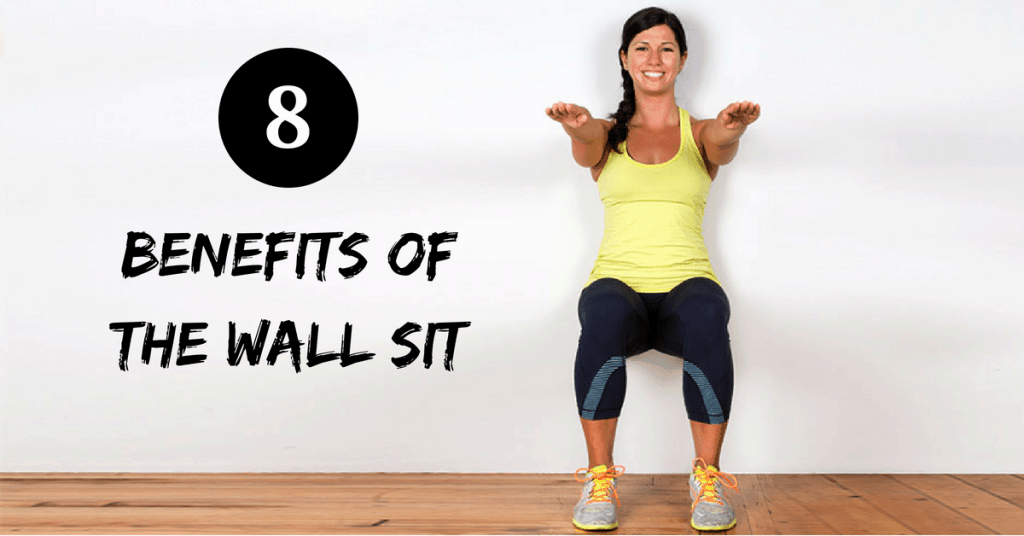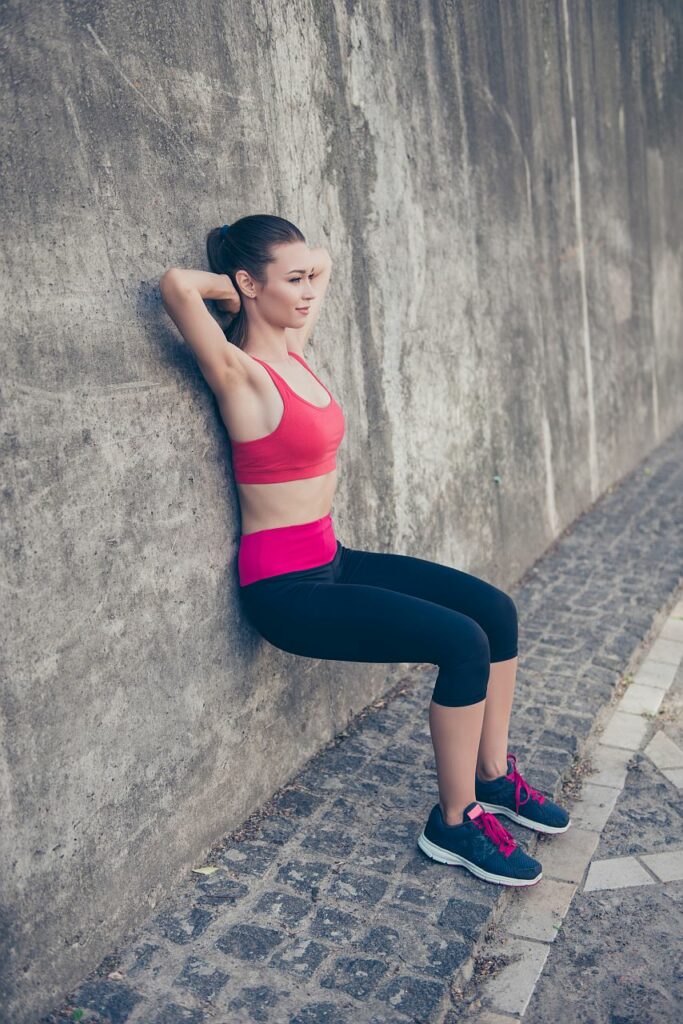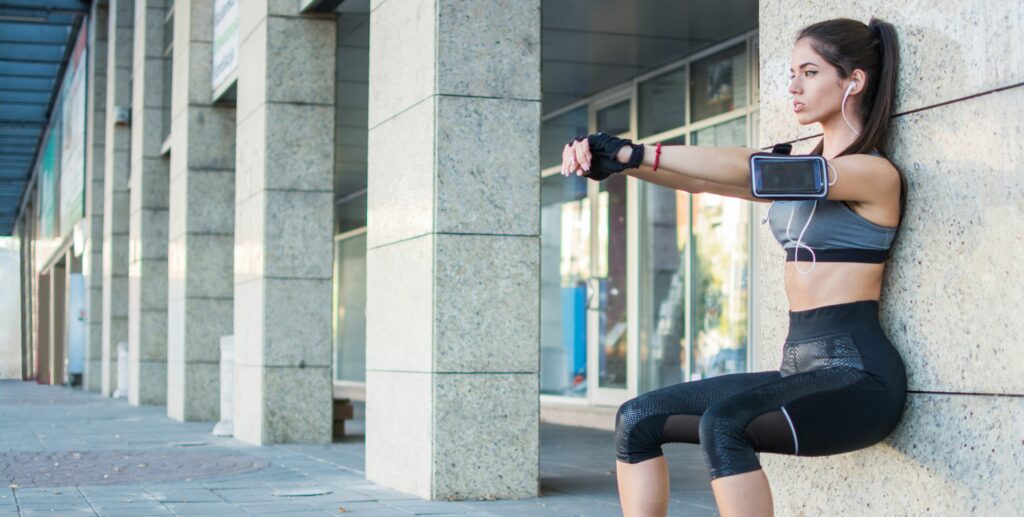The wall sit is overlooked as a leg exercise due to its simplicity. Wall sits are simple because they only require a flat vertical surface and provide numerous benefits at any skill level. Beginners and experts alike use wall sits to increase endurance, burn calories, implement easy variations, and more without overcomplicating the exercise.

We tend to associate complex and advanced exercises with superior effectiveness. We consequently saturate our workouts with ‘Instafamous’ exercises, like loaded squats and deadlifts, that aren’t easy for beginners. However, amongst all the impressive exercises that exist, the discrete wall sit has quite a few benefits that other more commonly performed leg exercises can’t provide.
Today, we’ll explore what a wall sits on, the position’s topmost benefits, variations, and commonly asked questions about the position.
Contents [show]
What is a wall sit?
A wall sit is an exercise position done over a period of time rather than over a specific amount of repetitions. The wall sit requires you to hold yourself in a seated position against a wall for a certain amount of time, normally between 30 to 60 seconds. The position predominantly works your glutes, quads, hamstrings. and your pain threshold. A handy feature of the wall sit is that you require no expertise to perform it, making it perfect for doing at home. All you need is a wall or any other vertical surface to lean against and you’re good to go.
Top 8 benefits of wall sitting
We’ve gathered eight of the top benefits of wall sits. We’ll also go over why you should consider incorporating a wall exercise into your workout routine and some variations to try out.

1. Works your entire lower body
The foremost benefit of a walk is that it works out your entire lower body. The wall sit is an isometric (static) exercise, but it functions as a compound exercise because it requires numerous joints and muscles to work in unison. Your glutes, your hamstrings, and your quads all get a workout. The main purpose of a wall sit exercise is not to increase muscle mass, but to increase muscular endurance. You will notice that you will be able to hold a wall sit for longer and longer periods of time over time. There are few lower body isometric exercises that require the use of all your major leg muscles, so the wall sit is considered unique in this way.
2. Burns a lot of calories
The second benefit of wall sits is how the position burns calories. Since a position is being held whilst performing the wall sit, rather than moved in and out of, as with an exercise that requires repetitions, the muscles remain contracted for the duration of the exercise. Wall sitting is unlike performing repetitions, whereby the muscles lengthen and contract with each repetition, providing periods of rest and no resistance.
After about 15 seconds of holding a wall sit you will notice your heart rate going up and the burn we all love to feel will be more than noticeable!
A higher heart rate results in more calories burned over a given time frame. This both boosts your metabolic rate (for short periods of time) and works your cardiovascular system.
3. Increases your endurance
The third major benefit of wall sits is increased endurance. We’ve covered that the wall sit isn’t necessarily for building muscle mass, nor should it be your go-to exercise for strength. But the wall sit will improve your muscular endurance.
How does it do this? By activating the Slow Twitch Fiber (or Type I Fiber) components of your muscles. These muscle fibers are responsible for your endurance, rather than your strength, which falls under the responsibility of Type II Fibers, or fast-twitch Fibers.
So, if you are a distance runner or someone who plays a running sport (such as basketball or football) you would benefit a lot from wall sits.
4. An alternative to squats
The fourth benefit of wall sitting is that the exercise functions as an alternative to squats. If you can’t perform squats for whatever reason, wall sits are a great alternative that will work the same muscle groups. If you can perform squats though, the wall sit should not be an alternative, but rather a supplementary exercise.
5. Great for skiers and boarders
The fifth benefit of wall sit exercises applies to skiers and boarders. If you are new to skiing, you probably don’t know that wall sits are the number one exercise performed by all skiers, beginner or advanced. Wall sits are commonly used by snow sports enthusiasts to condition themselves before hitting the downhill slopes after a long pre-season. The reason for this is that wall sits accurately emulate the skiing position and work the same muscles that are used when tearing up the slopes.
Apart from the added muscular endurance that wall sits provide, allowing you to stay in the skiing position for longer periods of time (i.e. have more fun), wall sits will also strengthen your kneecaps which can be under a lot of stress when skiing down bumpy slopes.
6. Can be done anywhere
The sixth benefit of wall sits is that they can be done anywhere. Wall sits’ applicability is probably one of its most important advantages. You can do them anywhere, at any time, and without any equipment needed. This is a huge benefit if you don’t have the time to go to a gym.
7. Fun to do
The seventh benefit of wall sits is that they’re simply fun to do. For some (surprising) reason, many people simply enjoy doing wall sits. There are literally thousands of wall sit contests and challenges done online, some involving the whole family from the 7-year-old child to his or her 70-year-old grandparent.
8. Lots of variations (See wall sit exercise ideas below)
The final benefit of wall sit exercises is the number of variations you can do. The following variations help push your body to new limits and add versatility for when and if you grow bored with the standard wall sit.
-
Single-Leg Wall Sit

Once you are in the standard wall sit position, extend one leg out in front of you at a time in an alternating fashion from left to right, shifting the load onto your stabilizing leg. You can keep the leg extended for a few seconds, or simply perform it in simple ‘one-second hold’ repetitions.
-
Wall Sit/Curl Combo

Bore easily? If so, why not do something in the time you’re ‘just sitting there’ and work your upper body at the same time? This could be done by incorporating a weighted upper body exercise to your wall sit, like a dumbbell shoulder press or some hammer curls. (Need dumbbells? Check out this guide)
-
Weighted Wall Sit

As we mentioned previously, holding the wall sit for longer periods of time will become achievable as you progress. However, not everyone has time in their day to sit against a wall for 10 minutes.
So, this variation is a way to make your wall sit extra challenging without having to increase the duration. Once in a wall sit position, place a dumbbell or weight plate evenly across your thighs, or hold a slam ball. (See our buying guide for slam balls).
As opposed to any other wall sit variation, this one does have the added benefit of strength gains.
How to do wall sits correctly

Getting the hang of wall sits is easy because the exercise itself is straightforward. Follow the steps below to conduct wall sits correctly.
- For starters, in a standing-up position, lean against your vertical surface of choice.
- Next, walk your feet out away from the wall (once in your wall sit position, your knees should not track over your toes), and have them shoulder-width apart. While leaning back on the wall, slide down until there is a 90-degree bend at both your hips and knees.
- Hand placement can be on the wall next to you or crossed in front of you but should not be placed on your thighs unless you are a beginner requiring some assistance to start off with. Placing the hands on your thighs will make the exercise less difficult.
- Your back should be leaning against the wall with your head, neck, and spine in a neutral position.
And that’s how you get into a perfect wall sit position! You will know you are doing it right if you feel your body weight in your heels, not in your toes, and your quads and hamstrings start to burn after 15 to 20 seconds.
Another important thing to remember is that when you are fatigued, you should push or slide yourself up against the wall back to a standing position. Don’t crumble down to the ground. It can cause a lot of damage to your knees, especially when your muscles, tendons, and ligaments are fatigued.
Wall Sits FAQs
What muscles do wall sits work?
Wall sits are an isometric exercise that mainly works the quads, glutes, and hamstrings. Wall sits may also work the calves. For example, variations of wall sit help work the adductors (which are often overlooked during training). To work the adductors with wall sits, put a medium-sized exercise ball between your knees while performing the wall sit. Squeeze the ball with your knees and you’ll feel those inner thighs burn!
What are wall sits good for?
Wall sits are good for building endurance and baseline strength through the quads. Being the biggest working muscle in our legs (that get a lot of work), usually they don’t need to be isolated and strengthened on their own. Therefore, exercises like squats are usually preferred over wall sits.
However, there are some cases where you would want to isolate the quad muscles with wall sit exercises, including the examples list below.
- Increasing quad stamina
- Improving stability
- Building strength (for people with particularly weak quads)
- Sport-specific endurance
Remember that wall sits do not provide a complete workout. You will still need to do exercises to work your other leg muscles, such as lunges and hamstring curls, so you don’t overtrain your quads.
Do wall sits build muscle?
No, wall sits do not build muscles. Wall sits are primarily used for building stamina, endurance, and stability rather than bulk. Wall sits primarily target the quads, glutes, and hamstrings, which are already the strongest muscles in the legs. The exercise can be used to build muscle mass (and a shapely behind). However, you’d be better off with squats or step-ups for building muscle.
Do wall sits burn calories?
Yes, wall sits burn calories. Everything you do burns calories, including sitting here reading this right now. Therefore, wall sits also burn calories. Whilst wall sits do burn calories, they are less known for their calorie-burning effects and better known for their ability to build muscular endurance.
How long should you do wall sits?
Ideally, you should do wall sits for 30 to 60 seconds in sets of 3. If you are a beginner and can’t hold wall sits for very long, start off with 5 sets of 10 to 15 seconds and build up to being able to do 30 continuous seconds.
Once you can easily do wall sits for 60 seconds, consider variations such as the one-leg wall sit, or adding some extra weight.
How to make wall sits easier?
There are several ways to make wall sits easier. Being in the right position makes it easy by providing you with comfort in terms of your posture. Should you require assistance when starting out, place your hands on your thighs and support a bit of your body weight so you’re not fully loading your legs.
Focusing on contracting your abdominal muscles while doing the wall sit which will help stabilize your body and make it easier to hold the position for longer.
And finally, don’t hold your breath! Oxygen is required for blood flow. Consistent breathing through this exercise will help you gain the stamina needed for wall sits.
What’s the difference between wall sits and squats?
Wall sits are a type of isometric exercise. With isometric exercises, the body is in a static position. While the muscles are under strain (and thus being strengthened), they do not change position. The tension is in the same location.
By contrast, squats are a type of isotonic exercise. This means that the body is in motion, and the muscles extend and contract. The stretching of the muscles causes more tissue damage and thus helps build muscle better. Squats also activate more muscles during their range of motion.
Of the two exercises, squats are much better for building muscle and strength. However, isometric exercises like wall sits are still important for building muscle stamina.
What are wall squats?
Wall squats are the same as wall sits but with more movement. Wall squats are a combination of an isometric and isotonic exercise. To do a wall squat, hold for 10 seconds and slowly go back to your starting position by stretching your legs completely. And repeat.
Start at one set of 15 repetitions daily and slowly increase that to three sets of 15 repetitions daily.
Conclusion: Wall sit exercises

Wall sits are an easy-to-do exercise that provides broad benefits with little to no preparation. Wall sits are simple to modify, improve your endurance, and work out your entire lower body with the help of a flat vertical surface. We challenge you to start adding a couple of sets of wall sits to your workout. If you happen to not train at all, start by doing a couple of sets of wall sits a week. Write down your wall sit-hold time on a piece of paper and review your progress after 4 weeks.
Finally, please bear in mind that wall sits should not be considered a full workout, but instead should complement an existing workout with other exercises.